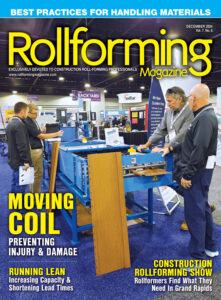By Phillip M. Perry
The Biden administration is issuing new OSHA regulations and stepping up enforcement in a move to ensure workplace safety. In response, businesses are retooling operations and sanitation procedures to protect personnel from accidents and Covid infections. A recent OSHA advisory describes steps to reduce the risk of violations.
Rollformers trying to avoid costly OSHA citations are facing new challenges in the form of heightened enforcement activity and greater liability for workplace Covid infections. As federal, state and local governments tighten regulations, more operators in the metal construction trade may find themselves retooling their shops to ensure compliance with stricter mandates.
“I think you’re going to see much more aggressive OSHA enforcement under the Biden administration,” says former OSHA head Edwin G. Foulke, Jr., now a partner in the Atlanta office of Fisher & Phillips (fisherphillips.com). He views a January presidential executive order, “Protecting Worker Health and Safety,” and new OSHA guidelines issued in March as leading indicators of a more robust regulatory fervor. The agency is widely expected to issue new workplace regulations under a so-called “emergency temporary standard” this year.
The new federal posture may also include a larger OSHA oversight staff. “The Biden administration says it wants to double the number of inspectors,” says William K. Principe, partner in the Atlanta office of Constangy, Brooks, Smith & Prophete (constangy.com). “While we don’t know if they will hire that many, it’s reasonable to assume there will be some increase. During the last administration vacancies weren’t always filled, so OSHA ended up being below the number of federal inspectors that had existed for a very long time.”
More inspectors mean more boots on the ground. OSHA observers expect an increase in the rate of inspections, along with more citations and higher penalties. And all this comes at a time when Covid is raising troublesome issues of its own. “The pandemic, with its greater safety requirements, has increased the risk of OSHA violations,” says Gary Heppner, a California-based independent OSHA safety advisor (riskmanagementaudits.com). He added that inspectors will be looking closely at how businesses are spacing personnel, mandating masks and cleaning the work environment.
Construction targeted
OSHA is expected to pay increasing attention to building sites. “Construction falls are among the most frequent causes of workplace injuries or fatalities,” says Mark D. Norton, Director of Norton Safety Services, Tucson, AZ. “Because of that, OSHA tends to focus inspection activity on that area.”
Observers cite an influx of new workers as a key reason for the spike in accidents. “In the economic downturn of 2007 and 2008, many employees left the construction industry,” says Norton. “When the economy rebounded, people were hired without the same level of experience and knowledge. Less trained workers and an increasing demand for construction is a recipe for more accidents.”
OSHA is also taking greater interest in machine shops, another environment with high accident rates, according to Heppner. Here Covid is having an effect: Workers, long required to wear safety glasses while operating certain equipment are now expected to use face shields and maintain appropriate distances from others. That can be difficult in restricted environments where people are working in close quarters. Any resulting laxity in safety considerations can spark illnesses and OSHA citations. While rollformers in rural areas might not be subject to the same degree of scrutiny as urban operators, they still face the risk of employee complaints being filed with OSHA.
OSHA mandates
Most employers want their workers to be safe and healthy. And given the higher OSHA profile, businesses will be making a special effort to meet state and federal standards. That means conforming to the “General Duty Clause” of the Occupational Safety and Health Act, requiring workplaces “free from recognized hazards that are causing or are likely to cause death or serious physical harm to employees.”
While the imprecise nature of the general duty clause allows leeway for employers to account for varying local conditions, it also leaves plenty of room for inspectors to find unexpected violations. The lack of specific guidelines prompted OSHA to issue a comprehensive guidance document earlier this year. “Protecting Workers: Guidance on Mitigating and Preventing the Spread of COVID-19 in the Workplace” lists steps employers can take to reduce potential spread. (Businesses can access the document at osha.gov/coronavirus).
Although the new guidelines are advisory in nature, OSHA observers expect specific regulations soon. “OSHA will likely issue an emergency temporary standard for workplaces,” says Foulke. This standard will carry the force of law and employers will be fined for non-compliance with its terms.
How strict will the regulations be? That is still to be seen. “The emergency temporary standard is not expected to be as employer averse as the OSHA regulations in California, but will likely resemble the Virginia standard, which follows CDC guidance,” says Foulke. Employers will likely be required to conduct workplace risk assessments and maintain written Covid-related action plans to include social distancing, masks, sanitation and training.
“One thing I think you’re going to see during the Biden administration is a focus on musculoskeletal disorders (ergonomics, repetitive motions, lifting) and combustible dust,” adds Foulke. “Also, I think sometime this year OSHA will go back to requiring that 250-plus employers in certain industries file not only 300A Summaries but also the 300 logs and the First Report of Injury forms.”
Employer organizations will likely litigate onerous OSHA rules. “Trade associations have been successful in the past in getting injunctions against OSHA regulations deemed outside the agency’s jurisdiction or overly burdensome,” notes Douglas E. Witte, who represents businesses in labor and employment law matters at Madison, Wisc.-based Boardman & Clark (boardmanclark.com). “Sometimes the regulations are modified, or simply delayed for a year or longer.”
Work-related illness
If an employee comes down with Covid and misses work time or goes to the hospital, is the illness recordable as work related? The answer is often less than clear. “Up until now, OSHA has not been pushing too hard on employers who claim COVID-19 infections occurred outside the workplace,” says Witte. Employers have been operating under fairly liberal standards, thanks to OSHA guidance issued in the spring of 2020 that allowed Covid illnesses to be categorized as not work related if an “alternative explanation” could account for the infections.
Unfortunately, the term “alternative explanation” is vague, and OSHA does not provide examples. “The guidance is being interpreted, by some, as indicating that if the employer can point to some exposure away from the workplace, then the case can be deemed not work-related,” says Principe. Others are even taking the position that because Covid is being spread everywhere an infection is not work-related unless the employee has continually commuted in their own car, stayed in their own house, and not gone to a grocery store or interacted with the public in any way.
That kind of liberal interpretation, though, skirts the edge of justice. “I think you need more concrete evidence that the employee was exposed to an infected person away from work,” cautions Principe. “Perhaps their spouse, children, or people they socialized with have Covid, or perhaps they attended a super-spreader event.” Faulty categorizations can be costly. “OSHA issues citations to employers who fail to properly record or report cases,” says Principe. “The agency is often tipped off by whistle blowers, or they get word of infections through hospitals or public health departments.” Penalties for serious violations start at $13,653, although the amount is sometimes reduced in the event of a good-faith history. Citations for willful or repeated issues start at $136,532.
Certainly, there is no need to record cases that are clearly not work-related. While an employer may do so out of fear of a citation, being too inclusive can backfire. “Over-reporting can spark an OSHA inspection when the entries from an employer’s logs are entered on their 300A Summaries,” says Foulke. “Those are available for review not only to OSHA but also to plaintiff’s lawyers and community activists like Common Cause. Skewed numbers can impact a business’s ability to get future work from clients.”
So how about those cases that fall into a grey area? “My advice to employers would be that in the case of doubt, record or report the event,” says Principe. “You can always explain the facts, saying that you don’t believe it is work-related for the following reasons, but that you are including the case out of an abundance of caution. This will protect you from a citation.”
Many OSHA observers believe the Biden administration will tighten criteria, determining that more infections occurred in the business environment. There may be a return to earlier CDC guidance which mandated that an illness be designated work related if the employee had been within six feet of another Covid-infected worker for a total of at least 15 minutes. “The agency may start tracking infections down to employer facilities if they can do so and support the change by claiming they are trying to halt the spread of Covid,” says Principe.
Finding help
While the prospect of an OSHA inspection and citations can disturb any metal fabricator, the federal agency can also be helpful. “Many businesses believe that every interaction with OSHA is negative,” says Norton. “They don’t realize that OSHA also provides consultative services at both the federal and state level.”
At the employer’s request, says Norton, OSHA will inspect the machine shop for problem areas. While there is no charge for the service, the employer has to agree to fix whatever OSHA finds. “It’s all confidential, so nothing uncovered by the inspectors gets shared with the compliance side.”
That proactive approach can prevent costly citations down the road. “It’s very important to take the right steps to reduce the risk of infection in the workplace,” says Principe. “This will keep employees from getting sick and the employer out of trouble. I encourage businesses to track the OSHA and CDC websites on a regular basis. Know what the recommendations are. Then if OSHA shows up at the door everything will be in order.” RF


















